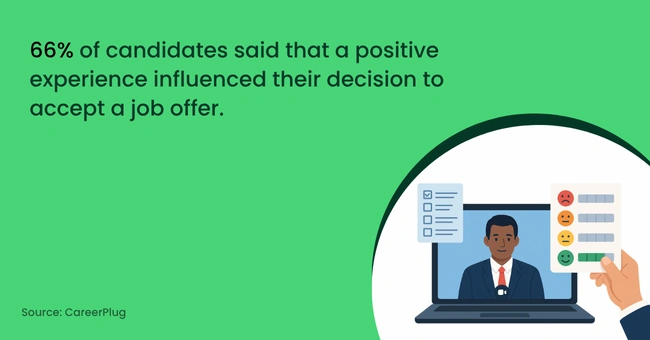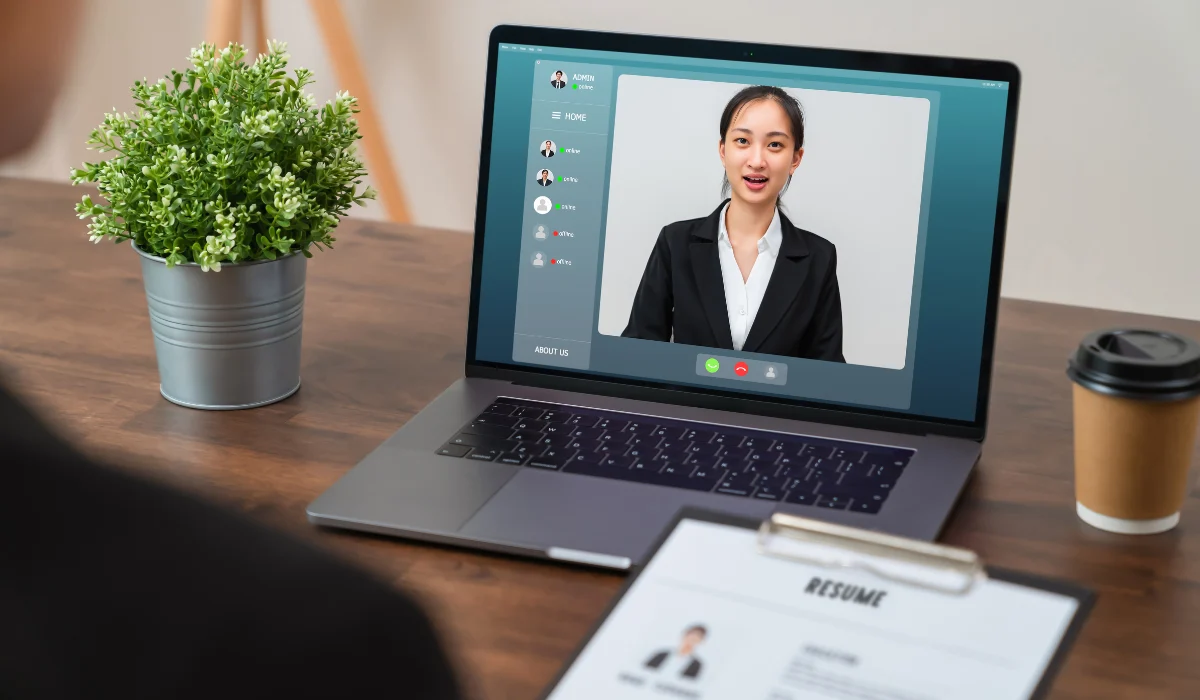
How to Measure Candidate Experience in One-Way Interviews?
Nov 13, 2025 |
One-way video interviews have become a staple in modern hiring. They're efficient, scalable, and save hours of scheduling time. But here's the catch: while they streamline your process, they can also make or break your hiring success if the candidate experience isn't right.
A clunky interview process doesn't just frustrate candidates; it damages your employer brand, increases drop-offs, and costs you top talent. The good news? You can measure candidate experience with the right approach.
In this guide, we'll cover the key metrics that reveal how candidates feel about your one-way interviews and practical strategies to create a smoother, more engaging process.
TL;DR
- Measuring candidate experience helps you understand how applicants feel about your hiring process and what needs improvement.
- Key metrics like completion rates, drop-offs, CSAT, and cNPS reveal where candidates face challenges or disengage.
- Use short post-interview surveys and platform analytics to gather insights and track progress over time.
- Improve the experience by simplifying instructions, offering flexibility, and keeping communication clear and human.
- Analytics turn feedback into action, helping you make data-driven improvements that boost engagement and employer brand.
- With ScreeningHive, you can easily track these metrics and deliver a smoother, more candidate-friendly one-way interview experience.
What Is Candidate Experience in One-Way Video Interviews?
Candidate experience in one-way video interviews is how candidates perceive the entire asynchronous interview process from invitation to final submission. Unlike live interviews with real-time interaction, one-way interviews are self-guided. Candidates record answers independently, which means they rely on:
- Clear instructions: They need to know what's expected without someone to explain.
- Platform usability: The interface must be intuitive and easy to navigate.
- Fairness: Questions should feel relevant and unbiased.
- Timely communication: Updates and transparent timelines matter more without human touchpoints.
- Technical reliability: Any glitch can frustrate and derail the experience.
Every detail counts when there's no real-time interaction. A confusing interface or vague instructions can turn promising candidates away.
Why Recruiters Should Measure Candidate Experience
Measuring candidate experience isn't just a nice-to-have; it's essential for any modern hiring strategy. Understanding how candidates perceive your process helps you measure candidate experience effectively so you can identify strengths, uncover pain points, and make your recruitment more efficient.
1. Better employer branding: Positive candidate experiences get shared on social media, LinkedIn, and Glassdoor, helping you attract top talent. On the flip side, negative experiences can spread just as quickly, potentially harming your reputation.
2. Higher completion rates: When the interview process is smooth and intuitive, more candidates complete their interviews. This reduces wasted time for recruiters and ensures you get a full pool of candidate insights.
3. Improved engagement: Measuring experience helps you understand what resonates with candidates. This insight enables you to create interactions that feel fair, professional, and candidate-friendly, ultimately improving the quality of hires.
4. Data-driven decisions: Metrics provide concrete, actionable insights that go beyond gut feelings. By analyzing candidate experience data, you can refine processes, optimize workflows, and make informed decisions that enhance your overall hiring strategy.
Without measurement, you're hoping candidates had a good experience, but you never really know. With it, you can spot and fix problems before they cost you great talent.
According to a report by CareerPlug, 66% of candidates said that a positive experience influenced their decision to accept a job offer. This highlights how crucial it is for recruiters to focus on improving every stage of the candidate journey from the first interaction to the final offer to attract and retain top talent.

Key Metrics to Measure Candidate Experience in One-Way Video Interviews
1. Interview Completion Rate
This shows how many candidates who started actually finished the interview. It's one of the clearest indicators of process health.
Low completion rates signal unclear instructions, complicated processes, technical issues, or candidates losing interest. Track this over time and by role to identify areas of concern.
2. Drop-Off Points
While completion rate tells you how many finished, drop-off points show you where candidates quit. Common exit points include:
- Instruction screens (too confusing)
- First questions (unclear or intimidating)
- Mid-interview (too long or technical difficulties)
- Final submission (unclear next steps)
Identifying these friction points helps you simplify instructions, adjust questions, or improve technical support.
3. Candidate Feedback and Satisfaction Score (CSAT)
Post-interview surveys provide direct insight into candidate feelings. Keep them short with focused questions:
- "Was the interview process easy to follow?"
- "Did you feel the interview was fair and clear?"
- "What would you improve?"
Use simple rating scales (1-5) for quantitative data and include open-ended questions for qualitative insights.
4. Candidate Net Promoter Score (cNPS)
This measures how likely candidates are to recommend your process to others. Ask: "On a scale of 0 to 10, how likely are you to recommend this interview process to a friend?"
- Promoters (9-10): Great experience
- Passives (7-8): Satisfied but not impressed
- Detractors (0-6): Unhappy and might share negative feedback
Calculate cNPS by subtracting detractor percentage from promoter percentage. A high cNPS indicates positive experience; low scores signal needed improvements.
5. Technical Barriers
Track reported technical issues like login problems, recording failures, or upload errors. Technical barriers have a direct impact on satisfaction and engagement.
Monitoring these issues helps you ensure a smooth, stress-free experience that keeps candidates engaged.
With these metrics identified, the next step is learning how to collect and analyze the data effectively.
How to Collect and Analyze Candidate Experience Data
Collecting and analyzing candidate experience data is crucial if you want to measure candidate experience and understand how your one-way interviews are perceived. By combining direct feedback with platform analytics, recruiters can gain a comprehensive view of what works well and where improvements are needed.
- Use short surveys: Send CSAT and cNPS surveys immediately after interviews. Keep them under 5 questions to maximize response rates.
- Leverage platform analytics: Most one-way interview platforms provide built-in analytics for completion rates, drop-offs, and technical issues. Review these regularly.
- Combine quantitative and qualitative feedback: Numbers show what's happening; open-ended responses explain why. Together, they give you the full picture.
- Review data regularly: Set monthly or quarterly reviews to spot trends and measure improvement over time.
Strategies to Improve Candidate Experience in One-Way Video Interviews
After collecting and analyzing candidate experience data, it’s time to take action. Implementing targeted strategies helps create a smoother, more engaging interview process that candidates appreciate. Improving communication and reducing friction points can significantly enhance the overall experience.
- Simplify instructions: Use clear, concise language. Include video tutorials or FAQs to guide candidates through the process.
- Personalize communication: Send warm, friendly invitation emails that explain why you're excited about their application and what to expect.
- Ensure platform usability: Test your interview platform regularly. Make sure it works seamlessly across devices and browsers.
- Offer flexibility: Give candidates reasonable time windows to complete interviews. Respect their schedules.
- Be transparent: Clearly communicate timelines, next steps, and what candidates can expect after submission.
- Close the feedback loop: Respond promptly after interviews, even if it's just acknowledging receipt and sharing timelines.
Link improvements back to your metrics. If drop-offs decrease after simplifying instructions, you know it worked.
How Analytics Can Enhance Candidate Experience
Analytics turn candidate experience data into actionable insights for improving one-way video interviews. By analyzing these metrics, you can measure candidate experience more accurately, identify friction points, and make informed, data-driven decisions
- Identify patterns: Spot which roles, question types, or interview lengths cause the most friction. For example, long or unclear questions might consistently lead to drop-offs.
- Test improvements: Run A/B tests with different instructions, question orders, or interview formats to see what increases completion and satisfaction.
- Benchmark performance: Compare your metrics against previous hiring cycles or industry standards to gauge how well your process is performing.
- Make data-driven decisions: Use the insights to refine processes, reduce technical issues, and optimize communication. Decisions based on data are more reliable than assumptions.
The result? Higher candidate engagement, a stronger employer brand, and more efficient, effective hiring.
Conclusion
When you measure candidate experience in one-way video interviews, it’s not just about tracking numbers; it’s about understanding how candidates truly feel during the process. When you monitor key metrics like completion rates, drop-off points, CSAT, cNPS, and technical barriers, you gain real insight into what's working well and where improvements are needed.
With ScreeningHive, you can turn those insights into action. The platform makes it easy to deliver a seamless, engaging, and stress-free interview experience. From built-in analytics and easy collaboration to personalized communication and flexible scheduling, everything is designed to help you connect better with candidates.
By combining meaningful data with ScreeningHive's intuitive one-way video interview tools, you can create a smoother, more human hiring experience, one that saves time, strengthens your brand, and helps you hire the right people faster.
Frequently Asked Questions (FAQs)
1. What is candidate experience in one-way video interviews?
Candidate experience is how candidates feel about the entire asynchronous interview process, including clarity of instructions, platform usability, fairness, communication, and technical reliability.
2. Why is measuring candidate experience important?
Measuring candidate experience helps improve completion rates, engagement, and employer branding. It also provides actionable insights to optimize your hiring process.
3. Which metrics should I track to measure candidate experience?
Focus on key metrics like interview completion rate, drop-off points, candidate feedback (CSAT), candidate NPS (cNPS), and technical issues.
4. How can I collect candidate experience data effectively?
Use short surveys, platform analytics, and open-ended feedback. Regularly reviewing this data helps identify friction points and improve the interview process.
5. How can analytics enhance candidate experience in one-way interviews?
Analytics reveal patterns, friction points, and trends in candidate behavior, helping you refine instructions, question formats, and platform usability for a smoother experience.

.webp.dat)





